Saturday
Cooking Demonstrations
|
We thought we
felt a little morning chill the other day. That means autumn
is around the corner as is the resumption of our Saturday Cooking
Demonstrations! Join us each Saturday at 10:00 a.m. to gain
new knowledge from some of the area's cooking experts. No
reservation required. $5 per attendee.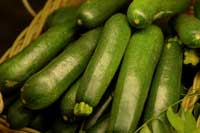
Saturday, Sep 8th - Time for Brunch -
Margaret Welder - These eye-opening ideas won't call for an early
wake-up. Margaret will share recipes for a Baked Caramel Apple
French Toast that can be made the night before and delicious
Pineapple Scones, using dried pineapple and cream
cheese.
Saturday, Sep 15th -
Zucchini -
Beatriz Spalding - A popular summer squash, fresh zucchini is
available year-round and can be cooked by a variety of methods
including steaming, grilling, sautéing, deep-frying
and baking.
Saturday, Sep
22nd - From Your
Garden - Robert Moore - Good-looking, good tasting,
and good for you! There is nothing quite like fresh fall
produce from the farmers' market or your garden for recipes that are
truly delicious, light, and a snap to prepare.
 Saturday, Sep
29th - A Taste of Indian
Bread - Rama Sridhar - Nothing beats the warm,
aromatic, homemade taste of Indian breads! Today you will
enjoy full-flavored, handcrafted bread. Rama will show us how
to do the basic rotis and baranathas and variations as
well. Saturday, Sep
29th - A Taste of Indian
Bread - Rama Sridhar - Nothing beats the warm,
aromatic, homemade taste of Indian breads! Today you will
enjoy full-flavored, handcrafted bread. Rama will show us how
to do the basic rotis and baranathas and variations as
well.
Saturday, Oct 6th -
Autumn Dinner
Ideas - Karen Davis - Join Karen as she shares some of
her favorite autumn recipes. Orange-Glazed Pork Tenderloin is
wonderful roasted in the oven next to Savory Sweet Potato
Fries. Take home ideas suitable for casual dinners and easy
entertaining.
Saturday, Oct
13th - Warm Up with Fall
Soups - Margaret Welder - Two Welder family favorite
recipes will use the last of the garden produce -- Stuffed Pepper
Soup and Salsa Soup! Both are easy to make for a family
supper. While the soup simmers, Margaret will bake some simple
garlic buns using frozen bread dough.
Saturday, Oct 20th - Wickedly Wonderful Halloween
Fun - Andrea Moore - Halloween is full of
surprises! Andrea will dish out some special surprises and
treats for us to take advantage of for the holiday.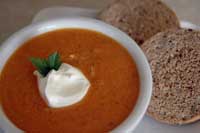
Saturday, Oct 27th - Cheese Blintzes and
Otherwise - Joe Geha - East meets East in an
Arab-Jewish potluck. Joe will demo blintzes (Jewish crepes)
made with the traditional blended cheeses and fruit fillings.
Others he'll fill with "Mirkatan" (the Arab touch), a dried fruit
and nut mixture macerated in jasmine tea and brandy, and finished
with a sprinkling of pomegranate seeds.
November 3, 2007 - Pie Revisited -
Margaret Welder - You'll have another chance to get Margaret's
piecrust recipe! She'll make an Apple Almond Cream Pie, which
has an almond-paste cream layer with the apples, and her Pumpkin Pie
which uses sweetened condensed milk.
November 10, 2007 - Smart Cookies! -
Andrea Moore - Baking cookies is the brightest idea of the holiday
season! It is a whole lot of fun (especially if there are kids
around) and they make an instant party (think tree trimming or
cookie exchanges). When they are all wrapped up they're a
great last minute gift! Andrea will get us all ready for the
most festive of seasons with some new
recipes! |
The Eating Table
|
|
Food has always
brought people together. Holiday parties, family
gatherings, birthdays, and fond memories are all celebrated at the
table. Experiencing the joys of those special
meals involves more than just the food; it's also
the ambience that invites us to relax, reflect, and nurture our
communal spirits as well as our bodies.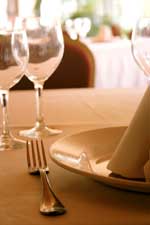
It all begins
with setting the table. From elevation of an
everyday supper meal, to the most special of occasions, choose a
style of dining for enhancing:
Informal
Gatherings - Gather a few close
friends, try some new recipes, fashion a creative table setting, and
let the good times roll. Centralized serving
dishes encourage guests to congregate nearby while mixing tastes and
stories.
Dinner
Parties
- After a summertime full of casual eating, blend your creative
forces with your organizational skills and plan a more formal
occasion. From the details of counting out the
dishware, polishing the silver, and unfolding the tablecloth, to the
selection of serving accessories, the evening's composition evolves
and emerges.
Everyday
Mealtimes - If the family is too
starved to wait for a centerpiece, everyday meals can still be made
special with colorful placemats and dishware set invitingly for a
calm moment.
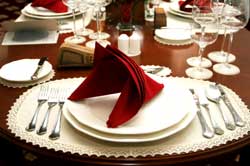 Once the context is set,
serving styles will also help to define the
event: Once the context is set,
serving styles will also help to define the
event:
Family
Style -
With this informal style, diners serve themselves from bowls and
platters passed around the table. Food makes its way around the
table in a counter-clock motion; dishes always moving to the
right.
Buffet
Style -
Separate from the eating table, the spread is laid out as one
sumptuous feast. Warming trays, chafing dishes,
and ice beds will keep "Hot foods hot, and cold foods
cold." This style of serving works well for
larger groups or when entertaining in small
spaces.
Plated
Style -
A more formal style, the food is arranged on the plate and brought
to seated diners. The old rule stated, "Serve
from the left, take from the right," but this may vary slightly in
different situations. The overriding rule is to
serve in the least obtrusive manner. Always pour
drinks from the right of the guest.
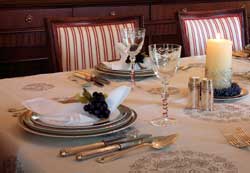 Table
etiquette - It's one of those
things enjoyed silently when present, but glares embarrassingly when
it's not. Slurping soup from a spoon, scooping
your hand into a communal dish, or dipping fingers in a cleansing
bowl, are all appropriate ways to eat, as long as you're in the
right country! While etiquette varies with the
culture, some practical tips will help provide confidence when
setting the table, dining with your family, or partaking at a lavish
dinner party: Table
etiquette - It's one of those
things enjoyed silently when present, but glares embarrassingly when
it's not. Slurping soup from a spoon, scooping
your hand into a communal dish, or dipping fingers in a cleansing
bowl, are all appropriate ways to eat, as long as you're in the
right country! While etiquette varies with the
culture, some practical tips will help provide confidence when
setting the table, dining with your family, or partaking at a lavish
dinner party:
- When setting
the table, center the dinner plates, place forks to the left,
knives and spoons to the right. The cutting
edge of the knife faces toward the plate.
- For
successive courses, utensils should be used from the outside of
the setting to the inside.
- Place used
utensils on your finished plate parallel with each other at the
four o'clock to ten o'clock position. Any
utensils necessary for dessert will arrive with the dish when
served.
- If a knife
is used to cut food into smaller pieces, cut only one or two bites
at a time.
- If you need
to step away during a meal, fold your napkin informally and place
it to the left of your place setting.
Alternatively, you may place the napkin on your chair, but
not if the napkin is soiled.
- "Keep your
elbows off the table!" "Sit up straight!" Your mother was
right!
- When in
doubt, follow the lead of your host and
hostess.
|
Linens Set the
Stage
|
|
Linens lay the
foundation for a wonderful dining experience. A
table adorned with a beautiful tablecloth, runner, or placemat helps
distinguish the formality of a meal. Whether it's
crisp white linen or cotton splashed with autumn colors, each sets
the stage.
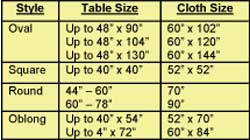
Sizing your
Tablecloth - Tablecloths are
categorized into four shapes: oval, square, round or
oblong. To ensure a proper fit, measure your
table by its length and width, (if rectangular or oval), or by its
diameter, (if round). Record the measurement in
both inches and centimeters (1 inch = 2.54 centimeters).
The fabric that hangs over the edge of the table, "the drop,"
can vary from 6-10 inches for casual settings, 16-24 inches for more
formal settings, or 29" for a full-length (near to the floor)
drop. Add twice the "drop" to each dimension of
the table to appropriately size your tablecloth choice.
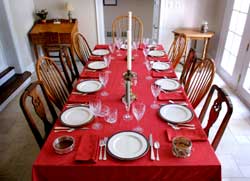 Caring for your
Tablecloth - Tablecloths made of
100% linen, cotton or a linen-cotton blend will clean up easily.
Moving linens from the washer at the completion of the spin cycle,
and removal of the items from the dryer when "just dry" will help to
reduce wrinkles. Spread flat to finish drying,
then fold for storage. Most ironing can be avoided this
way. When on the table, ironed creases in
tablecloths and napkins are acceptable if they lay straight and
square with the table. Caring for your
Tablecloth - Tablecloths made of
100% linen, cotton or a linen-cotton blend will clean up easily.
Moving linens from the washer at the completion of the spin cycle,
and removal of the items from the dryer when "just dry" will help to
reduce wrinkles. Spread flat to finish drying,
then fold for storage. Most ironing can be avoided this
way. When on the table, ironed creases in
tablecloths and napkins are acceptable if they lay straight and
square with the table.
Heirloom lace
tablecloths or other treasures may be hand-washed or sent to a
professional laundry for proper cleaning. Linen
experts recommend The Laundry at Linens Limited
in Milwaukee,
WI, for expert care of your finest cloths. At
home, follow the recommended instructions to preserve the integrity
and longevity of the material. Hang your linens
or roll them on an acid-free tube for storage. If hanging, use a
sturdy hanger made of polyethylene plastic, not polypropylene; the
latter releases a gas that causes the linen to yellow and weaken
over time.
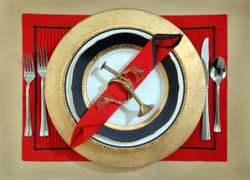 Dishtowels - 100% linen is
a highly absorbent fabric taking on up to 20% of moisture
before feeling damp! The fabric's ability to dry
quickly makes it perfect for dish
towels. Dishtowels - 100% linen is
a highly absorbent fabric taking on up to 20% of moisture
before feeling damp! The fabric's ability to dry
quickly makes it perfect for dish
towels.
Placemats - Individual mats are
an easy way to protect the table while letting its beauty shine
through. Placemats are great for everyday use,
and tasteful styles are perfectly appropriate for formal
settings. Pacific Merchant offers a great
variety of easy to clean colors and styles.
Cloth
Napkins
- Casual or formal, and fully recyclable, cloth napkins add the
final touch to a beautiful table setting. Whether
folded into a swan, fleur de lis, or snuggly wrapping the
silverware, they make a quick and easy table accessory. (See below
Tips for napkin folding link).
|
The Place
Setting
|
|
A great looking table is
marked by neatness and balance. Start with a
beautiful center arrangement, positioned on the table such that
each place setting is a similar distance away. Each
component in the place setting demands impeccable placement and
alignment with each place setting similarly ordered to the
next; symmetry reigns.
Place settings vary by
occasion and menu, and the accompanying diagrams illustrate standard
ways to set the table for casual, informal or formal
events.
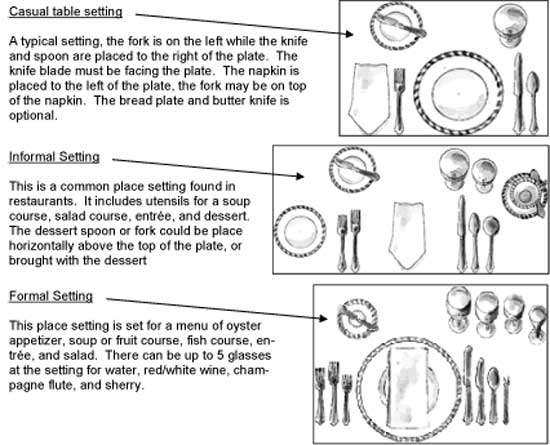
Diagrams reproduced with
permission from The Emily Post Institute.
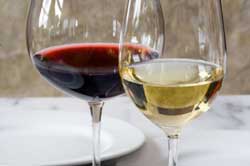 Glassware - Whether water, wine,
or an after dinner sherry, a fine glass in the hand is a sumptuous
experience all on its own. Some prefer the weight
of a heavy crystal stem, others the thinnest shell on a stiletto
stem. Following the Bauhaus tradition of design,
"form follows function," Riedel Glassware has transformed the
wine drinking experience with hand-crafted glassware skillfully
designed to enhance the uniqueness of different wine varieties.
Claus Riedel, the 9th generation of
Riedel glass experts, discovered that the shape of the glass affects
the perceived taste of beverages. Tall, narrow
glassware tends to force a person to tip their head back, while a
large, wide-mouthed glass draws a person's head forward, each
position alerting different combinations of taste buds as the fluid
flows. Glassware - Whether water, wine,
or an after dinner sherry, a fine glass in the hand is a sumptuous
experience all on its own. Some prefer the weight
of a heavy crystal stem, others the thinnest shell on a stiletto
stem. Following the Bauhaus tradition of design,
"form follows function," Riedel Glassware has transformed the
wine drinking experience with hand-crafted glassware skillfully
designed to enhance the uniqueness of different wine varieties.
Claus Riedel, the 9th generation of
Riedel glass experts, discovered that the shape of the glass affects
the perceived taste of beverages. Tall, narrow
glassware tends to force a person to tip their head back, while a
large, wide-mouthed glass draws a person's head forward, each
position alerting different combinations of taste buds as the fluid
flows.
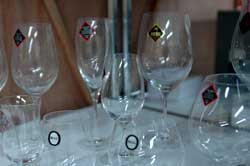 Riedel manufactures both
lead crystal (24 - 32% lead) and lead-free glass.
The lead adds sparkle and softness making for a more delicate
product. Among the several collections of
stemware produced by Riedel, the lead-free Vinum Extreme
Series® is one of our favorites. It is an
especially sturdy glass, yet possesses the delicacy of the finest
crystal. Riedel manufactures both
lead crystal (24 - 32% lead) and lead-free glass.
The lead adds sparkle and softness making for a more delicate
product. Among the several collections of
stemware produced by Riedel, the lead-free Vinum Extreme
Series® is one of our favorites. It is an
especially sturdy glass, yet possesses the delicacy of the finest
crystal.
Because alkaline
ingredients in most dishwasher detergents can cause an irreversible
cloudy film on delicate glass, Riedel recommends
hand-washing
their products and letting them air dry upside down on a clean linen
towel. For added shine, hold the glass over a pot
of boiling water to steam, then polish with a linen
towel.
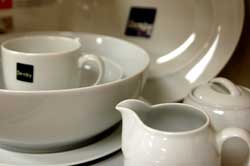 Dinnerware - From china to lexan,
the variety of dinnerware is extensive. The
colors of dinnerware can be coordinated with the linens and even
with your food. Many "all white" dinnerware
choices span casual to formal affairs while showcasing foods
beautifully. Recycle or dispose of
chipped or cracked pieces; the flaw may harbor bacteria, or break
further when exposed to hot or cold foods. We
specialize in dinnerware from Denby and
Vietri. Dinnerware - From china to lexan,
the variety of dinnerware is extensive. The
colors of dinnerware can be coordinated with the linens and even
with your food. Many "all white" dinnerware
choices span casual to formal affairs while showcasing foods
beautifully. Recycle or dispose of
chipped or cracked pieces; the flaw may harbor bacteria, or break
further when exposed to hot or cold foods. We
specialize in dinnerware from Denby and
Vietri.
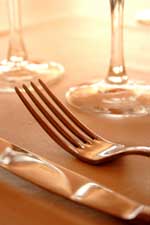 Flatware - Flatware choices
range from sterling silver to stainless steel. Since silver
tarnishes easily and requires frequent
polishing, stainless steel has largely replaced it
on today's tables. Sterling silver does,
however, have an interesting history. It grew
popular in the 18th century with elaborate ten-course Victorian
meals requiring dozens of pieces for each person.
The "silver craze" peaked from 1870 to 1920. Women,
who could not legally own land, could own household
property, and often acquired silver, one piece at a time.
Monogrammed with their initials, young women kept the flatware in a
hope chest in anticipation of establishing their own
household. Women have since replaced silver polishing with
land ownership. Flatware - Flatware choices
range from sterling silver to stainless steel. Since silver
tarnishes easily and requires frequent
polishing, stainless steel has largely replaced it
on today's tables. Sterling silver does,
however, have an interesting history. It grew
popular in the 18th century with elaborate ten-course Victorian
meals requiring dozens of pieces for each person.
The "silver craze" peaked from 1870 to 1920. Women,
who could not legally own land, could own household
property, and often acquired silver, one piece at a time.
Monogrammed with their initials, young women kept the flatware in a
hope chest in anticipation of establishing their own
household. Women have since replaced silver polishing with
land ownership.
|
Plan Ahead
Tips
|
|
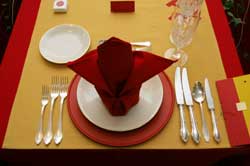 Tip #1:
Impress your guests with exotic napkin folds; this task can
be accomplished days in advance. Check out the step-by-step
instructions for 27 designs at napkinfolding.com. Tip #1:
Impress your guests with exotic napkin folds; this task can
be accomplished days in advance. Check out the step-by-step
instructions for 27 designs at napkinfolding.com.
Tip #2: Set the table with
linens, flatware, dinnerware and glassware a day in
advance. Cover the entire table with a lint-free,
clean, white sheet, or an older tablecloth to prevent dust and pets
from intruding on the pending party.
|
Q & A
|
|

Q: What
is a plate charger?
A: A
charger is a large plate that acts as a place holder and platform
for the different dinner courses at a formal meal.
The soup course, salad course, etc., are placed on top of the
charger. Chargers are a great way to add color
and sophistication to a formal table and are removed with the plate
before the dessert course is served.
Q: Bones,
pits, and "oddities" sometimes land in our mouths during a
meal. How does one finesse their
removal?
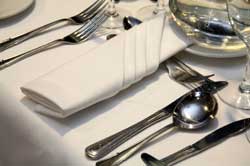 A: The
rule of thumb is "how it went in, is the same way it should come
out." So if a salad olive has a pit, it may be
removed from your mouth onto your fork and placed back onto the
salad plate. If the piece of food has been
chewed, discreetly dispose of it in your napkin. A: The
rule of thumb is "how it went in, is the same way it should come
out." So if a salad olive has a pit, it may be
removed from your mouth onto your fork and placed back onto the
salad plate. If the piece of food has been
chewed, discreetly dispose of it in your napkin.
Q: What
does the 18/10 notation on my stainless steel silverware refer
to?
A: The
"18" corresponds to the percentage of chromium and "10" to the
percentage of nickel. This ratio represents the
finest grade of stainless flatware. In order to
be classified as stainless steel, it must contain at least 10.5%
chromium. Both metals aid in the prevention of
corrosion while nickel contributes to luster and
hardness.
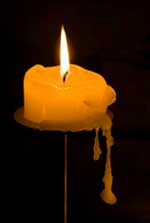 Q:
How can I remove candle
wax from my tablecloth? Q:
How can I remove candle
wax from my tablecloth?
A:
While lit candles look
great and establish ambience, wax drippings are not the least bit
romantic. Prevention is the best angle, but if
candle wax does manage to get on the tablecloth or placemat, grab an
ice pack, a credit card, an iron, and 2-6 brown paper bags or kraft
paper. Place the ice pack directly on the wax to
freeze it; this will make the wax brittle and easier to break
away. Any remaining wax may be removed by gently
scraping with a credit card or a dull butter knife.
With the excess removed, place one bag under the linen and
the other on top. With the heat set on low, iron
the bag and slowly move it around. The heat will
transfer the remaining wax onto the bag. Replace
bags as needed and continue until all remaining traces of the wax
residue are removed.
|
| Recipe |
|
Before the crush of the
holidays, get together with some of your favorite people for a
dinner party this fall. Polish the silver, dust
off your crystal, and retrieve your favorite serving
pieces. Make a multi-course meal with this fall
menu: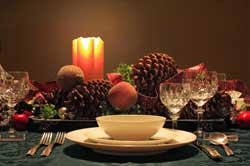
Autumn Dinner Party
Menu:
Soup
Course:
Savory Pumpkin Soup with Sour Cream
Salad
Course:
Baby Romaine Leaves, Dried Cranberries and Toasted
Walnuts
with a Danish Bleu Cheese
Dressing
Palate
Cleanser: Pomegranate
Granita
Meat
Course:
Pork Tenderloin with Mustard-Caper Sauce
Vegetable
Side:
Oven-Roasted Potato Quarters with Rosemary
Vegetable
Side:
Steamed Broccoli
Bread: Sourdough Rolls with
Butter Curls
Dessert: Apple and Fig Crostata
with Brown Sugar Ice Cream
After-Dinner
Drinks:
Calvados Brandy over ice
Click here for a
printable version of the Recipe - (PDF
Format)
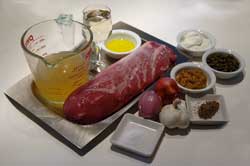 Pork Tenderloin with
Mustard-Caper Sauce Pork Tenderloin with
Mustard-Caper Sauce
(1) 2 lb. pork
tenderloin, trimmed of fat
1-2 T. extra virgin olive oil
1 t.
coarse sea salt
1 t. freshly ground black pepper
2 garlic
cloves, minced
1/4 cup finely chopped shallots
1 cup chicken
broth
1/4 cup dry white wine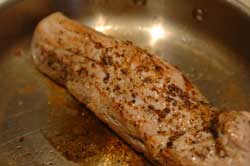
2 T. capers,
drained
3 T. coarse ground Dijon mustard
3 T. sour
cream
(1) Heat the oil over
high heat in an oven-safe skillet or pot that has a cover.
(2)
Season the pork by rubbing the outside of the tenderloin with salt
and pepper.
(3) Place the tenderloin into the pan and sear,
turning, until browned all over, 5 to 10 minutes.
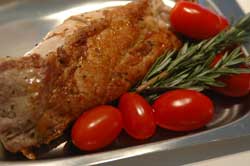 (4) Cover and transfer
the pan to a 425 degree oven for 45 minutes, or until an internal
temperature of 160 degrees is reached. (4) Cover and transfer
the pan to a 425 degree oven for 45 minutes, or until an internal
temperature of 160 degrees is reached.
(5) Remove the pork from
the pan, cover with aluminum foil and let rest for 10 minutes while
preparing the sauce.
(6) Transfer the pan with its juices to the
stovetop.
(7) To the juices in the pan, add the shallots and
garlic, sautéing for 1 minute.
(8) Add the chicken
broth and wine; boil until the sauce has reduced and is thick enough
to coat the spoon, about 10 minutes.
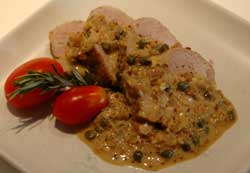 (9) Whisk in the
mustard, sour cream, and capers. (9) Whisk in the
mustard, sour cream, and capers.
(10) Whisk over medium heat
until heated through. Do not boil.
(11) Add water or additional
broth if the sauce is too thick.
(12) Slice the tenderloin into
1/2 -inch thick medallions and serve with the
sauce.
(The broccoli will
love this sauce as well!).
Recipe adapted from
Recipezaar. Used
with permission.
| |